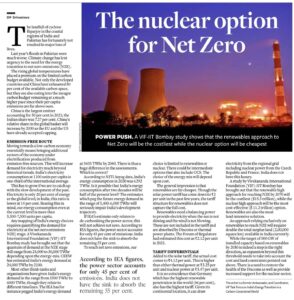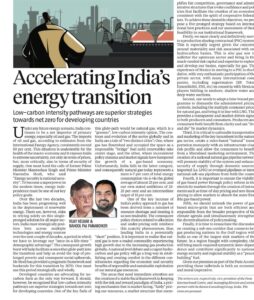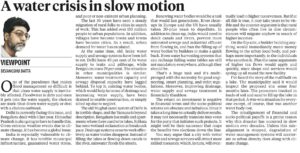Editorial 1: Net Zero emissions and Nuclear Option
GS 3 : Infrastructure: Energy, Ports, Roads, Airports, Railways etc.
GS 3 : Conservation, environmental pollution and degradation, environmental impact assessment.

Introduction:
- The recent landfall of Cyclone Biparjoy in coastal regions of India and Pakistan highlighted the urgency of addressing climate change and transitioning to a low-carbon economy.
India’s energy demand at the net zero emissions (NZE) stage and evaluates the viability of renewable and nuclear energy sources as potential pathways.
Assessing India’s Energy Demand:
- Different estimates exist regarding India’s future energy demand, ranging from 3,500 to 6,000 TWhr, with varying timelines.
- However, the discrepancy between these estimates and the current energy consumption level of 6,292 TWhr in 2020 raises concerns about hindering India’s development trajectory.
Net Zero Emissions and Sector Contributions:
- To achieve net zero emissions, India must focus on decarbonizing the power sector, which accounts for 45% of emissions.
- The remaining 55% of emissions cannot be absorbed within India’s current capacity.
- Renewable energy sources and nuclear power offer potential solutions, with the choice of energy mix depending on cost.
Cost Considerations and Tariff Structures:
- Renewable energy sources, such as solar power, have seen a decrease in tariff rates to ₹2 per unit.
- However, the actual cost is higher due to the need for balancing power when renewables are unavailable.
- Tariff differentials show that renewables cost ₹4.12 per unit, higher than thermal power (₹3.25 per unit) and nuclear power (₹3.47 per unit).
Renewables vs. Nuclear: Cost and Land Intensity:
- A study by the Vivekananda International Foundation (VIF) and IIT Bombay reveals that a renewable-focused approach to NZE by 2070 would be the costliest ($15.5 trillion) and land-intensive, requiring double India’s current surplus land (200,000 square km).
- In contrast, a nuclear-focused approach is the most cost-effective ($11.2 trillion) option.
Considerations for Expansion:
- India’s target of achieving 500 GW of installed capacity based on renewables by 2030 is a positive step.
- However, expanding beyond this threshold requires careful consideration of cost and land constraints.
- It is crucial to restore the health of Discoms (distribution companies) and provide increased support for the nuclear sector.
Conclusion:
As India strives to transition to a low-carbon economy and reach NZE, careful assessment of energy demand and the choice of energy sources is essential.
While renewables have seen cost reductions, the need for balancing power increases the overall cost, making nuclear power a more cost-effective option.
Balancing cost, land constraints, and the health of Discoms will be vital for a sustainable energy transition in India.
Editorial 3 :Roadmap to India’s Energy Transition
GS 3 : Infrastructure: Energy, Ports, Roads, Airports, Railways etc.
GS 3 : Conservation, environmental pollution and degradation, environmental impact assessment.

Introduction:
- India’s heavy reliance on imports for primary energy, particularly oil and gas, poses significant challenges to its macro-economy and energy security.
- To mitigate these risks, it is crucial for India to diversify its energy mix and reduce dependence on fossil fuels.
- While renewable energy deployment has seen progress, it is essential to adopt a multi-faceted approach and strategically position bets across multiple technologies and energy sources.
- This editorial explores the potential of natural gas as a low-carbon intensity option and outlines a five-pronged strategy to accelerate its growth in India’s energy sector.
- The Case for Natural Gas:
1.1 Low-Carbon Intensity Bridge Fuel: Natural gas is considered a “greener” energy source compared to other fossil fuels due to its lower carbon intensity. It can play a crucial role as a transitional fuel until renewables take center stage.
1.2 Global Perspective: The global gas sector has seen significant growth, occupying the space as a responsible bridge fuel. In contrast, India’s inconsistent policy framework and market signals have hindered the development of a gas-based economy, resulting in natural gas representing only a small fraction of total energy consumption.
- Addressing Policy Gaps:
2.1 Mindset Shift: India’s policy approach to gas has often been driven by a perception of resource scarcity, treating it as non-tradeable. This scarcity mindset has led to policy choices that reinforce the perception of shortage, perpetuating India’s dependence on imports.
2.2 Trade and Pricing Policies: Recognizing natural gas as a traded commodity and aligning pricing mechanisms with market dynamics can create transparency, encourage fair competition, and ensure resource pricing that reflects its value accurately.
2.3 Infrastructure and Governance: Establishing a stable fiscal framework, unbundling transportation and marketing, and creating a rules-based natural gas transportation monopoly can enhance confidence in the sector, stimulate investment, and provide a stable and secure supply of natural gas.
- Power Sector Reforms:
3.1 Viability of Gas-Based Power: Policy reforms in the electricity markets, such as time-of-day pricing and non-linear pricing, can support the viability of gas-based power generation. These measures enable flexible and efficient gas utilization while ensuring the integration of renewables.
3.2 Gas-Based Micro-Grids: Promoting the deployment of gas-based micro-grids offers an efficient and climate-friendly solution for decentralized power generation, contributing to both the climate agenda and the decentralization of policymaking.
- Regional Cooperation and Energy Security:
4.1 Sub-Sea Corridor: Resuscitating the discussion on a sub-sea corridor that connects gas-producing nations in the Gulf region with India as a significant consumer can foster symmetric interdependence, enhance national energy security, and contribute to regional stability.
- Unleash the power of gas– based micro-grids that are both efficient and responsible from the broader perspective of the climate agenda and simultaneously strengthen the decentralisation of policymaking
Conclusion:
India’s energy transition requires a comprehensive approach that leverages natural gas as a bridge fuel and strategically diversifies the energy mix.
By embracing a low-carbon intensity pathway and implementing the proposed five-pronged strategy, India can accelerate the growth of natural gas, enhance energy security, promote economic development, and contribute to its commitments under the Paris Accord.
This transition will require a combination of policy reforms, market-oriented pricing, infrastructure development, and regional cooperation, positioning India on a sustainable and resilient path towards a cleaner energy future.
Editorial 3: Water Crisis
GS 3 : Conservation, environmental pollution and degradation, environmental impact assessment.
GS 3 : Infrastructure: Energy, Ports, Roads, Airports, Railways etc.
GS 1 : Important Geophysical phenomena such as earthquakes, Tsunami, Volcanic activity, cyclone etc., geographical features and their location-changes in critical geographical features (including water-bodies and ice-caps) and in flora and fauna and the effects of such changes.

Introduction:
- Urban water management in India faces significant challenges due to climate change, rapid urbanization, and deteriorating infrastructure.
- As extreme weather events become more frequent, flooding poses a threat to clean water supply, leading to difficult choices between shutting down water supply or risking waterborne diseases like cholera.
- India’s vulnerability to climate change is exacerbated by poor municipal infrastructure, water stress, and inadequate urban planning.
- The migration of rural populations to cities has increased urban water demand, while aging and leaky water supply and sewage systems have been neglected.
- Furthermore, the drainage capacity has been compromised due to the loss of water bodies and ineffective systems.
- Deteriorating Infrastructure:
- Leaky Water Supply Systems: Cities like Delhi and Bengaluru suffer from significant water loss due to leaks and pilferage, resulting in inefficient water distribution and reduced supply.
- Inadequate Sewage Treatment: Water treatment and sewage disposal capacities have not kept pace with urban growth, leading to insufficient treatment of wastewater and its discharge into water bodies, further contaminating the environment.
- Neglect of Water Bodies: Construction projects and neglect have led to the draining and siltation of water bodies, compromising their role in drainage and water supply.
- Renewal of Water Bodies:
- Long-Term Commitment: Restoring water bodies and rivers requires sustained efforts over generations, as seen in river clean-up projects in Europe and the US.
- Desilting and Pollution Prevention: In addition to cleaning up water bodies, the focus should be on desilting canals and rivers, preventing untreated sewage and industrial effluent discharge, and halting the filling of water bodies by builders.
- Mandatory Water Harvesting: Implementing water harvesting systems to recharge falling water tables should be made mandatory across urban areas.
- Financial and Socio-Political Challenges:
- Negative Returns on Investment: Improving water and sewage services often has negative financial returns in the short term, making it an unattractive investment for municipal bodies.
- Lack of Immediate Political Benefits: The benefits of infrastructure projects may not be realized until long after their initiation, potentially leading to a lack of political incentives for undertaking them.
- Urbanization versus Rural Migration: Despite potential long-term benefits, rural people facing dire circumstances often migrate to cities in search of higher incomes, regardless of the quality of water and sewage services.
- Misalignment of Priorities:
- Builder Influence: Construction projects quickly generate revenue for urban local bodies and individuals involved, leading to a focus on such projects instead of long-term infrastructure improvements.
- Financial and Political Disconnect: The misalignment between financial returns and socio-political benefits hampers the prioritization of water management systems, contributing to their degradation over time.
- Accelerating Degradation: As urban density increases and climate change impacts intensify, the misalignment of priorities and deteriorating infrastructure will exacerbate the challenges in water management.
Conclusion:
Addressing the challenges in urban water management requires a comprehensive and long-term approach that prioritizes infrastructure renewal, pollution prevention, and efficient water resource management.
It is crucial to align financial incentives with socio-political benefits to encourage investment in water and sewage systems. By investing in sustainable water management practices, India can mitigate the risks associated with climate change, ensure access to clean water, and promote healthier and more resilient urban environments.
However, achieving these goals requires a collective effort from governments, municipalities, builders, and citizens to prioritize water management as a fundamental aspect of urban development.

